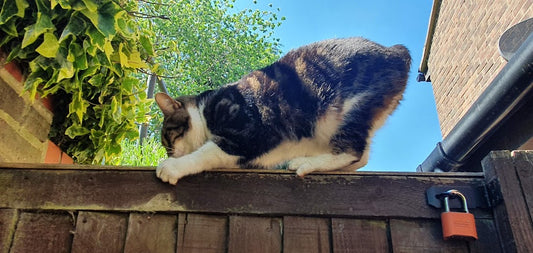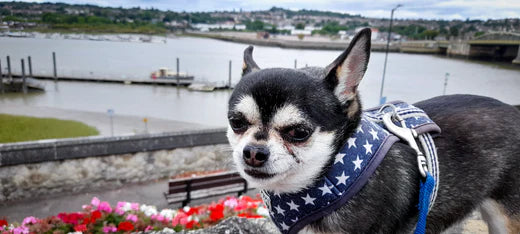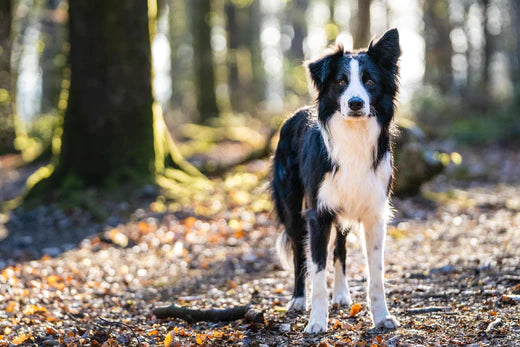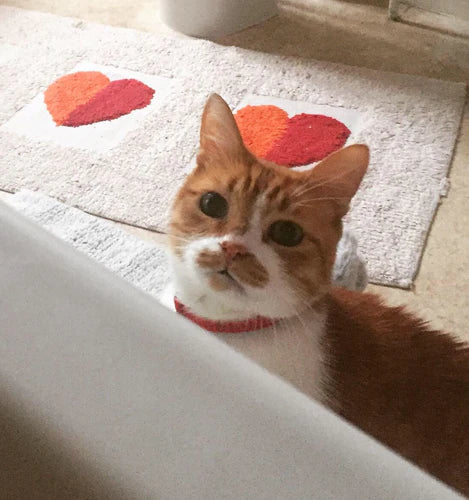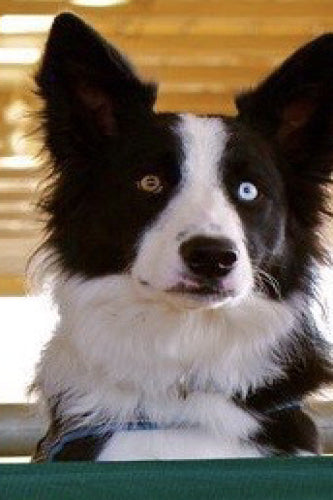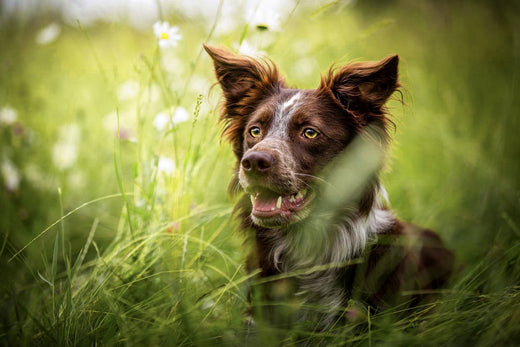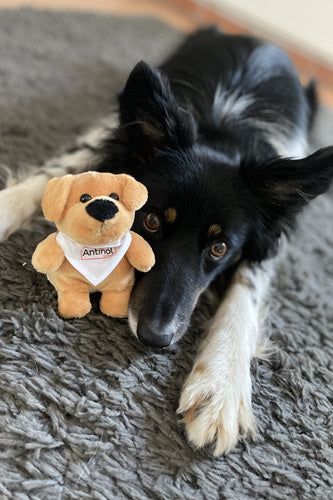Read our chat as we talk about all things dog agility, mobility, and what they would tell their 14-year-old selves now.
Q: Let’s kick off with some introductions. Tell us a bit about you, your competing dogs and your pack.
Martin: Hi, I'm Martin Reid. I have my old dog Flash; he's won two championship tickets. My dog after that is Spring, who's a retired nine-year-old. He has won 13 Championship tickets. And now I have three competing dogs. Snooze, who's on Team GB this year, competing at the European Opens and World Championships. Then I have Shape. She is four years old, and I hope she’ll compete in teams over the next few years. And finally, I have Selfie, who…
Naarah: Who’s amazing!
Martin: Yes, she's very natural. She’s also represented Team GB at the European Opens and will be representing them at the World Championships.
Naarah: I'm Naarah Cuddy. I have four dogs, two of which are retired. My first dog was Sassy; she was incredible for me. She’s 11 now, and she took me everywhere. We represented Team GB in 2015. She was my first dog at the European Open and the World Championships, where she came fifth overall in the world. Then I have Flair, who is eight. She has struggled a lot with her mobility, so she retired at two. And then my absolute dog of a lifetime is Lemon, who is now six, and she has taken me wild places!! She represented Team GB at the European Open Championships and the World Championships, where she got a team bronze medal. She has also been chosen to represent Team GB this year in the European Opens and the World Championships. Finally, my youngest dog is Banana. She is just two years old and just getting cracking with more serious training. She’s my baby and my wild child!

Q: Tell us about your training. How do you get a dog ready for the strains of competitive agility? Do you consider their mobility and joint health?
Martin: When training a young dog, one of the first things we do is teach them how to use their body. We do age-appropriate proprioceptive awareness exercises so that they learn where all their limbs are, which is really important as they grow. Even once they’re older and we’re working on fitness and learning the equipment, it’s still all about their bodily awareness. Getting them to understand how their body moves when it’s moving slowly as well as fast. They need to be able to do it slowly before we ask them for full speed out on a course.
Naarah: Yes, especially on equipment like the dog walk and running contacts—they've got to know where every foot is placed on the contact.
As they get a little older, competing at championship level, we do lots of water treadmill-based stuff and endurance.
They see a hydrotherapist and physiotherapist, and we also have an amazing specific sports vet, Lowri Davies.
And, of course, we consider their diet. My dog’s dinner concoction is quite something! And this is where Antinol has come into play for my dogs.
Q: So why did you start looking for a joint supplement? Did something kick that off?
Naarah: It was Flair, really. She was my second proper agility dog, and I had high expectations, but she would do random things like run around jumps, and there wouldn't be any need for it. I tried to help direct her, but I knew something was up.
Initially, we put it down to confidence, but when she started barking at me in the ring, I knew it wasn’t confidence.
She had joint stiffness, and I had to retire her. It was demoralising. I had put so much work into her, but it wouldn’t have been fair to her. She was stressed enough as it was from the joint stiffness. We didn’t want to exacerbate it. That's when we started thinking about extra support.

Q: What sort of things were you doing to support her?
Naarah: Once we retired her, she was managing day-to-day and was making good choices herself. Not zooming about too much on walks with Martin and his dogs, for example. We made lifestyle changes too. She would only go in the bottom cage in the van, and she always chose the lowest level bed. She’s pretty good at self-preservation.
Q: Did you try any other supplements before you found Antinol?
Naarah: I tend to throw everything at my dogs. So I’ve tried all sorts. We listen to recommendations from people we really respect in the industry. We had the dogs on a joint supplement, green-lipped mussel powder, boswellia, collagen, and mushroom powder. It’s quite a list!
So we tried a few supplements until I found what I believe to be the “Formula One” joint supplement, Antinol.
Q: Who recommended it to you?
Naarah: Initially, it was Dave Munnings who recommended it. I spent ages on the Antinol website. The tab was open on my phone forever. But the one thing that stuck with me was that it's not a byproduct. It's canine-specific, made specifically for dogs. It's not the waste product of a human product. Then Holly Barker, the Canine Sports Nutritionist, also recommended it when I asked what we should be putting them on.
Martin: Also, Lowri at SMART Clinic. We trust Lowri’s opinion, so if she says it's good quality, it means it's VERY good quality. She doesn’t work with a product if she doesn't believe in it. So when she does put her name to something, we know it's good.

Q: Did you do any research before you started Antinol?
Martin: We always do research into anything we use. We look online at the website, find out all the information we can, but then try to find other sources of information too. Ones that aren’t directly related to the manufacturer. So for us, Lowri’s advice and recommendation was the big thing. We trust that she’s done all her research, and we trust what she says.
Naarah: I agree. I don't profess to be an expert, but I need to know people in the know. So I’ve got Holly Barker, she’s a professional when it comes to food and has a really good understanding. Then I’ve got Lowri from SMART clinic—she told me to put my dogs on it. And there’s Natalie Mitchell, also from SMART clinic, and she is also a massage therapist. So I asked three separate people for three separate opinions, and they were all the same! So I don’t need to know myself; I just need professionals to know the products.
Martin: Yes, I’m very sceptical. I like it when several people whose opinions you trust have had good results with the product. If those professionals are saying, “yes, it's working. The dogs feel good. Their mobility is good. They’re not stiff in the mornings,” then I’ll try those products.
Q: What were your expectations before trying Antinol?
Naarah: My expectation was that I might not see any difference. I was happy to take that risk though. With the younger girls, they’re already fit and healthy, although I know it supports long-term optimal joint health. But I wasn’t expecting to see anything. I just gave it a try.
Q: So, the million-dollar question…what did you see with Antinol?
Naarah: It was Sassy. Sassy is hugely active for an 11-and-a-half-year-old dog. She's super crazy.
Martin: I can't stop her from running nowadays! When I take her out for a walk, it’s just chaos. She doesn’t stop the whole time, which keeps my dogs fit because they’re quite lazy on walks.
Naarah: She used to come back from those walks and look done in. But with Antinol, she doesn’t come in looking like she's gone two rounds with Mike Tyson! Plus, she’s chilled in the house now, not on edge. I think it took about four weeks to see the most difference.
Martin: With the younger dogs, we just wanted to support their bodies. Ideally, we want the dogs to retire when we feel like we want them to retire. Rather than be forced to retire because their bodies aren’t holding up. We want them to be able to enjoy their life and enter retirement happy and healthy.
Naarah: Yes, it’s important that they’re comfortable
Q: Do you have any tips to get dogs to eat their Antinol capsules?
Naarah: Mine just eat them as sweeties!! Normally I put it in their food, but if I forget, they’ll take them from my hand. Even Lemon, who is a really, really fussy eater!
Q: Would you recommend Antinol to other dog owners? Both agility and others?
Naarah: 100%. I already have. We run Into Shape Agility, an online agility website, and we have a private Facebook group. I’ve explained my experience on there and had lots of interest.
Martin: We believe it’s important to support your dog long-term, whether you compete with your dogs or not. I don't know why you wouldn't try it.
Q: So, back to agility. What do you know now that you wish you’d known back when you first started in the sport?
Naarah: I think I'm super picky now— I've learned a lot. I'm very precious over my dogs now. I won't run if the ground is bad or I think the course is incorrect. I won't run if they don't need to run. So if they're in a “win out” period and can't grade up this time, then I won't go to the show because it's another run for no reason.
I think also it's patience. When I started out, Sassy was a very frustrating dog because she's talented but also absolutely crazy. She taught me an awful lot of patience. But when I look back, I also see things with her that I wish I’d enjoyed more, that I can't have back now. I really try to enjoy my dogs more now while also trying to look after them at the same time.
Martin: For me, I'd be trying to tell myself that the things you do around agility to create the dog are more important than the actual agility training. It's those things that are going to help them be better at agility, be happier, and healthier. So think about fitness, treatments for the dogs, and nutrition and supplements for the dogs. They're all so vitally important to support the dog's peak performance and longevity.
Since we started, the rules and regulations have changed to support the dogs more, and the home care has also changed.
Q: What advice would you give someone just starting out in agility? Perhaps, 14-year-old you…
Martin: My piece of advice would be to make sure everything's really, really fun for yourself and the dog. Make sure you've got good, clear instruction in an environment where you and the dog are happy. So if you're going into classes, you and the dog are enjoying it, and you’re taking things in from watching other people. You can always learn from observing others.
Naarah: My advice would be to get a good coach. Get a good, fun, motivational coach because they'll already know the safety points you learn over time, so you don't have to worry about it. And they'll help mould you into a super cool motivational trainer yourself. Find someone you enjoy being around, that you trust, and that is always up to date with training methods.
If you’d like to learn more about agility training with Naarah and Martin, you can join their Into Shape Agility training platform here…


